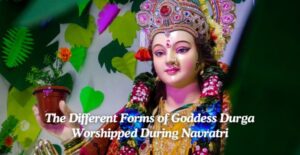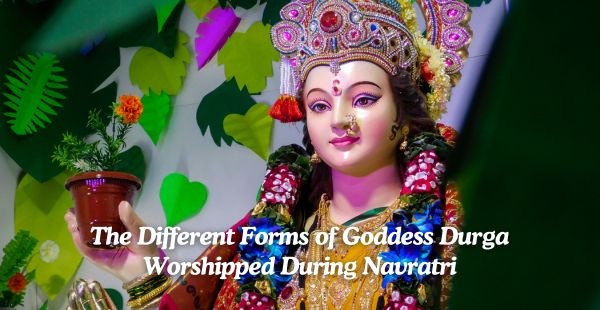
Navratri is a colourful and zestful festival which is dedicated to the Goddess Durga and her nine forms. All forms of Durga which are worshipped on each of the nine days symbolise different aspects of her strength, beauty and mercy. These are the goddesses who symbolize the victory of light over darkness and a path to those who want to find and receive might, intelligence, and blessings. Laying emphasis on Navdurga or nine avatars of Durga, here we are discussing each of them with a deep significance and moral attached to the day of the week.
1. Shailaputri (Daughter of the Mountains) Day 1
The first manifestation of Goddess Durga is Shailaputri, which translates as the daughter of the Himalayas. She as personifies strength and purity of nature in general. Sitting on a bull, with a trident in one hand and a lotus flower in the other hand Shailaputri is indeed the symbol of the strength of nature.
Spiritual Significance: The first day’s message regarding patience, discipline as well as resilience is a reminder that they are valuable attributes. This is where one becomes enlightened, when he or she finally finds something to ground himself in values and find himself or herself.
2. The second sanyasi that came into existence is Brahmacharini or the Ascetic – Day 2
Brahmacharini is the collector of knowledge; she is bare footed and has the divine aura. She has a kamandal (sacred water vessel) in the right hand and in the left hand there is a rosary representing devotion and control. The form represents harsh penance thus suggesting the value of the act of sacrifice and commitment.
Spiritual Significance: Specifically this day devotees spends their time trying to suppress ego and materialism and attempting to calm the mind and be present. The lady depicted by Brahmacharini is so patient and self-disciplined to the extent of being composed.
3. Acually named Chandraghanta (The Fierce Warrior) – Day 3
The third form is Chandraghanta is the destroyer form of the goddess who fights all the evils with the power of energy. With a sign of half-moon in her forehead, and her vehicle is tiger which signifies courage/someone who is fear less. The lady has many hands which hold weapons that are in a position to defend justice.
Spiritual Significance: People get courage and strength by worshipping this avatar of Lord Shiva known as Chandraghanta. Her roar eliminates all the undesirable elements and opens up the door to enter a new phase of peace and tranquillity. Basically, this day is all about accepting the strength with elegance.
4. Kushmanda the deity of the fourth day which means Cosmic Creator or the God of fire – Day 4
In the heart of the Sun there is Kushmanda, the god who created the universe, emanating light and heat. She was the one who is believed to have awaken the cosmos through simply smiling. She is gods’ goddess and of immense beauty, and she is shown as having eight limbs held decorative sacred items and she is seated on a lion.
Spiritual Significance: This day is all about creativity, light and positivism. Kushmanda is worshipped to bring in confidence, clearness and success. From void she declares existence and from existing comes prosperity.
5. Skandamata (Kartikeya’s Mother) – Day 5
The fifth form is Skandamata who is the mother of Lord Kartikeya, who leads the gods’ army. Sakti is depicted as sitting on a lotus with baby Karthikeya on one arm and the other hand grasping a lotus implying the roles of protection and motherhood. She emanates such a great amount of positive energy.
Spiritual Significance: Skandamata is a goddess that helps attract and open the door to persons, energies of love, protection, and nurturing within and around us. As a character, she embodies the beauty of motherhood, and love and encourages everyone to tap into their strength as well as care for other people.
6. When villagers prayed to Katyayani, she emerged in front of them as Katyayani Mahishasuramardini (The Destroyer of the Demon Mahishasur ) on the 6th Day.
The ferocious form of Katyayani more inclined towards as the warrior as she fights evil and brings justice to the world. Having a sword in her hand and mounted on lion she is called Katyayani because the sage named Katya first offered his worship to her. These are the main characteristics related to her persona: she is personified divine strength, courage and, empowering.
Spiritual Significance: Katyayani is worshipped so as to overcome all the hurdles one faces in life whether it can be in the form of relationship, career or self-enrichment. She is the goddess of will and courage that gives direction to the devotees to come out of the shell they don’t want to come out of.
7. Kalaratri – This translates as the Sick or the Dark Night of the Soul and it comes as the seventh day of this phase – Day 7
In fact the most formidable form of Durga as Kalaratri bestows the darkness and the night. With her untidy hair, and bright, passionate eyes, and a sword that does away with demons of ignorance and evil, she rises. Despite looking like the wicked witch, she is very much concerned with her devotees.
Spiritual Significance: This day is synonymous to confronting one’s worst nightmares and self-doubts. The devotees seek protection and strength from Kalaratri which drives negative energy out of them and enable them to fight challenges vigorously. She is a force of power and that darkness is the welcomed harbinger for light.
8. Mahagauri or the Goddess of Radiant Splendor – Day 8
On the victory over evil in her Kalaratri form, Durga takes her divine form as Mahagauri who is the goddess of purity and peace only. She is depicted riding a bull which has an elated radiance of face and is showering her devotees with bliss, wealth, and comfort.
Spiritual Significance: After a storm, relief and fresh air is brought about by Mahagauri. Paying tribute to her impersonates enlightenment, for she cleanses one’s spirit, thus being the harbinger of change or awakening. This day brings people hope and everything from the scratch.
9. Siddhidatri (The Bestower of Supernatural Powers) – Qualities of Goddess on 9th Day
On the last day Siddhidatri bestows perfection and knowledge on her devotees. Demeter is the mother who grants them all the powers they seek and she is sometimes portrayed as sitting on a lotus and emitting the power. Her blessings are the consummation of all that any man might imagine or wish to have.
Spiritual Significance: Siddhidatri is worshipped to become spiritually balanced as well as achieve all the materialistic goals of life. She avails the understanding of the balance of life – between the physical and the ethereal.
Navratri: We will go on having A Festival of Inner Transformation
In fact, there is more to Navratri than merely celebrating it as a festival; It is all about the spiritual awakening of the soul. Both forms of Goddess Durga are significant in teaching human beings important life lessons including power tuturance tenacity and wisdom. Indeed while we worship these nine forms, we not only celebrate the triumph of good over evil, but the triumph of the self over ones own internal conflict.
What we need to understand is that through the positive attitude and sentiments of Navratri, the energies of Durga need to be called into our lives, to rid ourselves of any darkness within. For strength, protection, love and knowledge – the Nav Durga are always available to help us in this holy journey.
As you spend your time worshiping the deity of Durgamma through these Navadurga or nine avatars and nights may her choicest blessings of health, wealth, happiness and spiritual well-being follow you.
Jai Mata Di!

